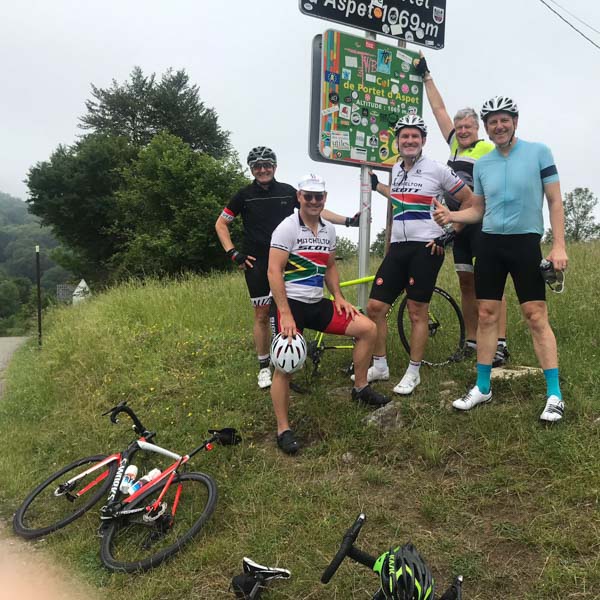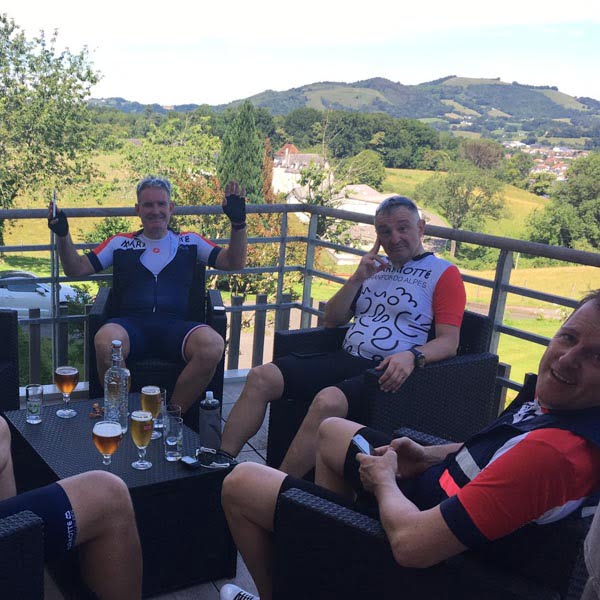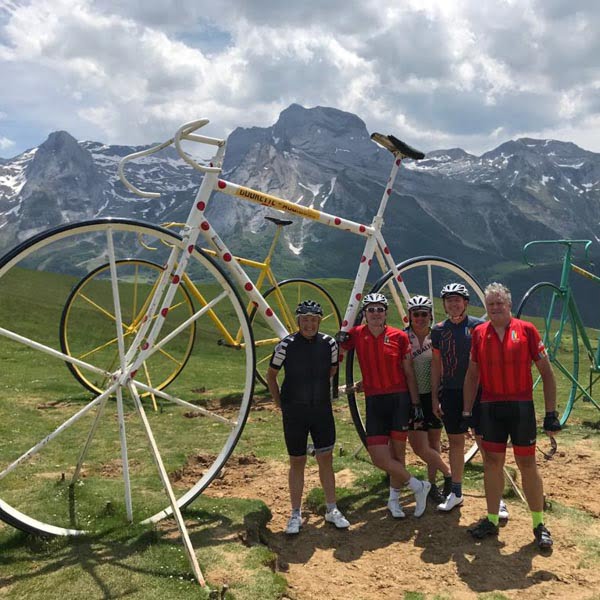Point to point challenge rides don’t get much better than the Raid Pyrenees, the classic Pyrenees coast to coast cycle route. It sees cyclists ride from the Atlantic to the Mediterranean, traversing the Pyrenees over giants like the Tourmalet, Aspin and Peyresourde.
There’s an official Raid Pyrénéen (or Raid Pyrenees) route that’s a timed challenge over a route between Hendaye on the Atlantic coast and Cerbère on the Mediterranean. More information on this (and the Trans Pyrenees race) below.
However, there’s no obligation to follow the exact Raid Pyrenean route and so different routes have developed, around accommodation options, timeframes, or to explore a slightly different range of cols on the way over the Pyrenees.
Cycling the Pyrenees coast to coast has been on our bucket list for some time, but we haven’t yet had time to squeeze it in. So, when Epic Road Rides community member Fritz Dittmann got in touch to tell us of his recent Raid Pyrenees adventure, we thought we’d ask him for all the details…
Enjoy!
The Trans Pyrenees features in our list of Europe’s best cycling routes – click through to find out why!
1. Tell us about the Pyrenees coast to coast cycle route – what and where is it?
We rode from Hendaye on the Atlantic to Canet-en-Roussillon on the Mediterranean. That’s a total of around 750km with approximately 14,500m of elevation.
We covered 11 cols in total:
Day 1 Col d’ Osquiche 495m
Day 2 Col de Aubisque 1709m
Day 3 Col du Tourmalet 2115m, Col d’Aspin 1489m, Col de Peyresourde 1569m, Col du Portillon 1293m
Day 4 Col de Mente 1349m, Col de Portet d’ Aspet 1069m
Day 5 Col de Port 1250 and Col de Puymourens 1920m
Day 6 Col de la Perche
We stopped/overnighted at Moulon-Lecharre, Luz Saint Sauveur, Pont Arross, Saint Girons, Puigcerda, Canet-en -Roussillon.
 Having conquered the Tourmalet!
Having conquered the Tourmalet!Note that the route we did is different to both the official Raid Pyrenees and the Trans Pyrenees race – it’s confusing that there are lots of events with similar names!
The official Raid Pyrénéen (or Raid Pyrenees) route is a timed challenge between Hendaye on the Atlantic coast and Cerbère on the Mediterranean. This route has been organised by Cyclo Club Béarnais since 1950. You can ride the official route in either direction (west-east or east-west, with west-east being the most popular). The 720 km route (with 18 passes and 11,000m of elevation gain) has to be completed in 100 hours or less, the 800 km route (with 28 passes and 18,000m of elevation gain) has to be completed in 10 days or less.
The Trans Pyrenees race is a self-supported ulra-distance cycling challenge. It’s organised by the same team as the Transcontintental Race. It takes riders 1,500km from the Bay of Biscay to the Balearic Sea and back again. Find out more in this article.
2. What prompted you to do the coast to coast Pyrenees?
We were planning a trip in the Pyrenees and wanted a point to point trip that would take in fantastic scenery and be an unforgettable experience.
A friend gave us the route and so we simply cut it into “doable” pieces.
I’ve managed to mislay the original Raid Pyrenean GPX route we used, but this is the same:
3. Give us an idea of what each day was like.
Day 1
This was an easy warm up into the Pyrenees. We started along the coast at Hendaye to Saint Jean-de-Luz then turned away from the Atlantic to the east. Once we hit the D918, we followed it to Moulon-Lecharre over the Col d’ Osquiche. As it was the “foothills” we did about 1,700m over the 122km.
Accommodation that night was in a nice old renovated Chateau Domaine Agerria. We alsohad a great lunch stop at a place called Café Ttipia in Saint Jean-Pied-de-Port.
Day 2
We started a bit late, due to a misunderstanding with the hotel… Anyway, once we got going we had a strong ride to the foot of the Aubisque at 80km.
The climb was tough and hot with a few horse flies to add to the discomfort. Got in to Luz-Saint Sauveur quite late around 18h30. The last section 20km was a bit boring and we were all a bit tired. Accommodation was poor.
Day 3
This was always going to be a biggie: four cols in one day. We started early into the Col de Tourmalet which seemed to go on forever. Then straight into the Col d’Aspin. We stopped halfway down the Col d’Aspin for lunch at a delightful little mountain hut. Run by an old lady, she fed us well, and the starter alone would have sufficed to get us up the next two cols! The Peyresourde was rather uneventful and the Col de Portillon was hot hot hot.
(As an aside, the sign at the bottom of the Portillon lies. It says average 6.6% but actually we found it was more like 9%.)
The last 10km to our hotel looked flat yet had a gradient of about 2 to 3%. I suppose after staring at 7 to 9% gradients all day, +3% looks like downhill!
 Day 1, the start of the Raid Pyrenean route on Hendaye beach, Atlantic coast
Day 1, the start of the Raid Pyrenean route on Hendaye beach, Atlantic coast Marker milestone on the Raid Pyrenees route
Marker milestone on the Raid Pyrenees routeDay 4
This was initially going to be a 98km downhill. Fortunately, I found a few cols, so changed the route to a manageable 85km with 1,600m of climbing!
We started off back-tracking the previous day’s 10km and flew for the first 30 kilometres. Col de Mente was steep with a patch of new gravel for about 2km which was horrible to ride on. The highlight was breaking through the cloud/valley fog near the top.
Col de Portet Aspet was also steep with about a 9% average and quite wet and damp – which was actually a nice change from the heat.
Our day finished early by the pool and a massage at the Chateau de Beauregard in St Girons. We ate a fantastic dinner cooked on an open fire with an old medieval rotisserie. Food was superb.
Day 5
The day started off well with a nice climb up the Col de Port (easy 4% to 6%) but quickly became a disaster after that. We ended up on the N20, the main road leading to Andorra complete with trucks traffic and a substantial hot head wind blowing from the south. A 50km stretch of torture.
The Col Puymorens was also not good, with the hotel and buildings on top being closed and derelict.
In better news, we spent the night in Puigcerda (in Spain) which was a nice place.
Day 6
This was the last day. We left Puigcerda early again to avoid the heat.
The first 20km was a hardly noticeable climb. Imagine our astonishment when we saw that we had just reached the Col de la Perche at 1579m.
From there it was all downhill to the coastal plain. Probably the longest downhill I have ever experienced past plenty of old forts and castles.
We finished early, in time for a swim and some lunch on the beach.
 Day 4 at the Col Portet de Aspet
Day 4 at the Col Portet de Aspet Day 6 on the Col de la Perche
Day 6 on the Col de la Perche4. If you had to pick your three favourite sections of the route, what would they be and why?
Day 1 the start along the coast…. The first day is always exciting and the coast was easy-going and pretty.
Day 3 all the cols were quite a challenge: lots of climbing with the heat to on top!
Day 6 the last day, to start at the top without having to grind for it and then to have a super long downhill was fantastic. The flat part, riding as a peloton, was also a great way to finish off the tour.
 Day 3, four big cols in one day (Tourmalet, Aspin, Peyresourde, Porthilon)
Day 3, four big cols in one day (Tourmalet, Aspin, Peyresourde, Porthilon)5. What were the best and worst things abut cycling the Pyrenees coast to coast?
Best, as always, was the camaraderie of cycling with my buddies and some of the great meals we shared.
The worst was definitely traversing the 50km along the N20 on day 5. What a disastrous route! Won’t do that again!
6. How fit do you have to be to ride the route?
We are all cycling fit (me the least with my lump of lard!) but we all do our weekly share of training.
However even the strong guys were tired after day 3; it became noticeable when those that always want to be first are happy to sit at the back…. Then you know they are fatigued.
 Enjoying a beer at the end of the day!
Enjoying a beer at the end of the day!7. What sort of logistics are involved in a ride like this?
We hired a van and a friend volunteered to drive it. I made the accommodation bookings (via booking.com) and each person sorted their own flights.
We were using our friend’s route, so it was just a matter of finding accommodation at or around the 120km mark each night.
8. Tell us about your kit choices.
Not much to say other than we each packed about 3 changes of cycling kit for hot weather and took one set for cold.
We managed to have the hotel wash our kit after day 3, which was very useful.
 Somewhere on the road with pretty fantastic scenery!
Somewhere on the road with pretty fantastic scenery!9. How did you organise your nutrition during the coast to coast ride?
We all had an emergency bar in our pocket and two bidons of water. As we had the van it was never an issue with supply. But it’s worth noting that we were drinking about 10 litres a day due to the heat! I personally had one bidon filled with one and one mixed water /coke for the sugar/energy (I find that is a good combo to prevent bonking).
Breakfast was mainly taken in the hotel and dinner was hotel or restaurant. Lunch was normally somewhere along the route.
We tended to stop every two hours for either a coffee or a meal.
10. What tips would you give to someone wanting to do this route?
We did the trip in the last week of June and it turned out to be super hot, yet at the same time images were coming in of the Gavia in the Italian Alps being shut due to heavy snow falls… Mountains are a weather law unto themselves. Thus the packing of 3 summer outfits and one deep winter one. Being a bit superstitious I am sure had we not taken the winter outfit it would have rained the whole week!
Avoid the N20 towards Andorra if possible or try and do it very early in the morning when it is cooler.
In the mountains 120km is a hard day. Perhaps rather do 100km with two cols than 120km with four, as it is much more relaxing getting to your destination early afternoon than early evening.
Start planning before Christmas and get your buddies to put their cash in the kitty…. That way you know they are committed.
 Unforgettable memories at the summit of the Col d’Aubisque
Unforgettable memories at the summit of the Col d’AubisqueBig thanks to Fritz for sharing his insights! It sounds like he and his friends had a fantastic trip – hopefully this helps you if you’re planning something similar.
More information about the Pyrenees?
If you want more information about cycling in the Pyrenees, you’ll find our in-depth Pyrenees guide here – our article on where to stay in the Pyrenees, tips for cycling the Pyrenees and interview with Paddy Sweeney (who used to run Velo Peloton in Argeles-Gazost) may also be useful.
For those that prefer to ride off road, check out our article on gravel cycling in the Pyrenees.
Want more challenge inspiration?!
Alternatively, if you’re after more ideas for big challenges you could take on, check out our articles on ultimate cycle challenges, cycling challenges in Europe and our pick of the best UK sportives.
This article on the 700 kilometre Route des Grandes Alpes may also be of interest!
We hope they’re useful! Let us know what you’re planning in the comments below!
Please support Epic Road Rides
A huge amount of time and effort goes into the article you’ve just read, all with the aim of helping you!
If you found what you’ve read useful, I’d really appreciate it if you dropped something in the tip jar here.
It’s a way you can say thank you and help us carry on creating top quality content with no annoying ads and no pay wall.
Looking for an organised cycling trip?
If you want someone to help you plan and book your cycling holiday, fill out this form. We aren’t a tour operator/agent but we work with lots of people who are and will do our best to put you in touch with someone that can help (within 24 hours wherever possible)!
The contents of this website are provided for general information purposes only. It is not intended to amount to advice and you should not rely on it. You should carry out your own due diligence and risk assessments and take professional advice. Views expressed by interviewees or other users of this website do not necessarily represent our views. We make no representations, warranties or guarantees, whether express or implied, that the content on our website is accurate, complete or up to date. If you use any information or content on this website, download from, or otherwise obtain content or services through our website, it is entirely at your own discretion and risk. Epic Road Rides Ltd disclaims all liability and responsibility arising from any reliance placed on the information and content on this website. Find out more here.

I am interested in cycling the Pyrenees route from Atlantic to Mediterranean. I will be flying from USA and plan to fly into Barcelona and then Bordeaux and take train to Saint-Jean-de-Luz. I will have my bike in a bike bag. How can I get my bike bag to Barcelona from Saint-jean-de-luz? Can I ship it? This is my biggest logistic complication.
Hi Jonathan, if your bike is in a bag, you might be able to take it on the train – but it will depend which train(s) you’re taking. More in-depth research needed on that one… Or perhaps this article will help? https://epicroadrides.com/cycling-blog/shipping-a-bike/